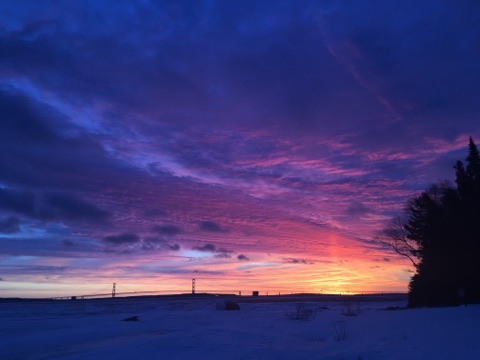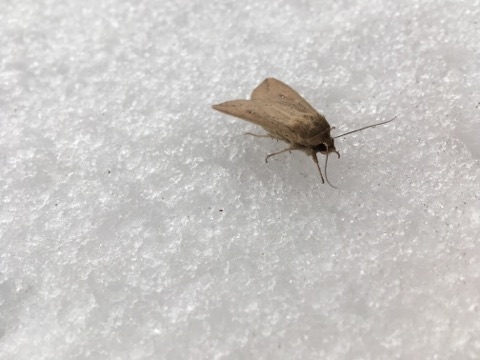4/11: Startled up a woodcock upon driving in—county bird!
Strong East-Southeast wind throughout the morning, which hovered around freezing. Bitter day, with depressed waterfowl migration probably due to wind and variable ice cover in the straits (at times around 50% as sheets were blown in). A few nice birds, though: another loon, all 14 cormorants from yesterday (once again out near St. Helena), and a single male pintail, all by himself, flying East. Gulls were getting absolutely battered in the air, but were moving throughout, with primarily almost-out-of-control Westward flights for the first three hours, transitioning to dogged Eastward flights by the fifth hour. Cut off counting around 11 to avoid recounts as some early fliers may have been out on fishing/foraging trips from the colony.
Passerines and raptors made limited flight attempts, though five starlings, some unid’ed passerines (likely red-wings), a rough-leg, and a female harrier making the trek across.
Headed out hopeful for an evening count around 4, but while running at the Headlands, a wicked blizzard kicked up, and by the time 5:30 rolled around I was limping the drive home through near-white-out conditions. Snow cleared around 7, but with lots of material still on the road, buffeting winds, and potential for more precip on the way, I decided to call the evening count. Hopefully the roads are clear tomorrow!
List: https://ebird.org/view/checklist/S54844444

4/12: Absolute bumper day! Big winter storm last night left the roads still a mess in the morning, but the wind had cleared much of the ice from around Mcgulpin, and had whipped up some wild seas. Wasn’t sure what to expect given the strength of the wind, but lots of waterfowl were moving! Most numbers weren’t particularly notable, but species diversity was high. Among dabblers/pond ducks, there were 21 mallards, 6 black ducks, 10 pintails, two pairs of wigeon (FOY for the point), a pair of gadwall (FOY), and a single wood duck, all headed due East into the wind.
Aythya were moving too, with 3 ring-necks (all male), 3 greater scaup (two males), and 3 redheads, plus another 35 that couldn’t be identified to species due to distance or height in the clouds (though most were probably redheads). Goldeneye and mergs were present in the usual numbers, though the goldeneye were moving almost entirely East, so they registered a high count of 24. Buffleheads came through in big numbers as well (also nearly all headed East), with 47 total birds.
Loons and grebes are here, too: a single horned grebe (FOY) was seen feeding just offshore, and a total of 13 loons passed (5 definite commons, 2 probable commons, and 6 possible red-throats, though these were about 4 miles off and impossible to be definitive about).
I’m beginning to suspect that ice cover has a huge effect on bird passage, as on previous days the arrival of large sheets of ice in the straits has seemed to immediately depress migration. This effect appears to be independent of wind speed (aside from the fact that strong windy days can blow more ice into the channel), as birds have been absent on previous strong windy days, but were very present today. Hoping I’ve been keeping track of this variable enough to use it in my final report.
As further anecdotal evidence for this hypothesis, today a long finger of an ice sheet was reaching out in a Northwesterly direction from the direction of Mackinaw City, and this repeatedly appeared to act as a “funnel,” as birds (especially Aythya sp., dabblers, and buffleheads) would come in from the West about a mile out, and gradually work their way right along the ice edge to pass close to shore. This apparent aversion to ice on the water would certainly make adaptive sense, as flying over a solid surface would make ditching to avoid an eagle attack essentially impossible (have yet to witness a successful eagle kill, but several are on the hunt every day). Curiously, the mergansers seem to be the exception to this rule, perhaps due to their stronger, faster flight.
In any case, besides waterbirds, it was a quiet morning. A single rough-leg (which looked a lot like the one seen yesterday) was seen headed Southeast, gulls were moving steadily East, and the robins appear to have gotten cold feet, as at least 120 came flying South from the UP to land on McGulpin Point!
An interesting incident after one flock passed: I heard agitated robin calls from somewhere towards the ice, but only saw a crow investigating a small crevasse between two bergs. The crow began reaching into the space, but hopped out quickly, somewhat ruffled. A robin proceeded to scream out of the crevasse and into the trees—unsure if it was looking for a drink, or perhaps became disoriented after the crossing. Either way, it had enough spirit left to avoid making a meal for a crow!
eBird list: https://ebird.org/view/checklist/S54866604

The remarkable run of waterfowl diversity continued for the evening count, where the winds had shifted dramatically, and almost all birds were now, accordingly, flying West.
An early pair of blue-winged teal (FOY) zipped by with a merg just after I arrived, followed by a male pintail, a wood duck pair, a wigeon pair, six redheads (plus 17 probable redheads), a male lesser scaup (FOY), also flying with a lone merg, a couple white-winged scoters, 10 long-tails, and 8 shovelers (FOY for point) right at sunset. Buffleheads and goldeneyes were weirdly absent, but red-breasted mergs picked up the slack, with strong Westward movements. Loons moved too, with 5 commons and two probable commons headed West.
Limited gull movement, and almost nonexistent passerines. A single great blue heron heading West rounded out the night.
eBird list: https://ebird.org/view/checklist/S54886250
Total waterbird species on the day: 21
